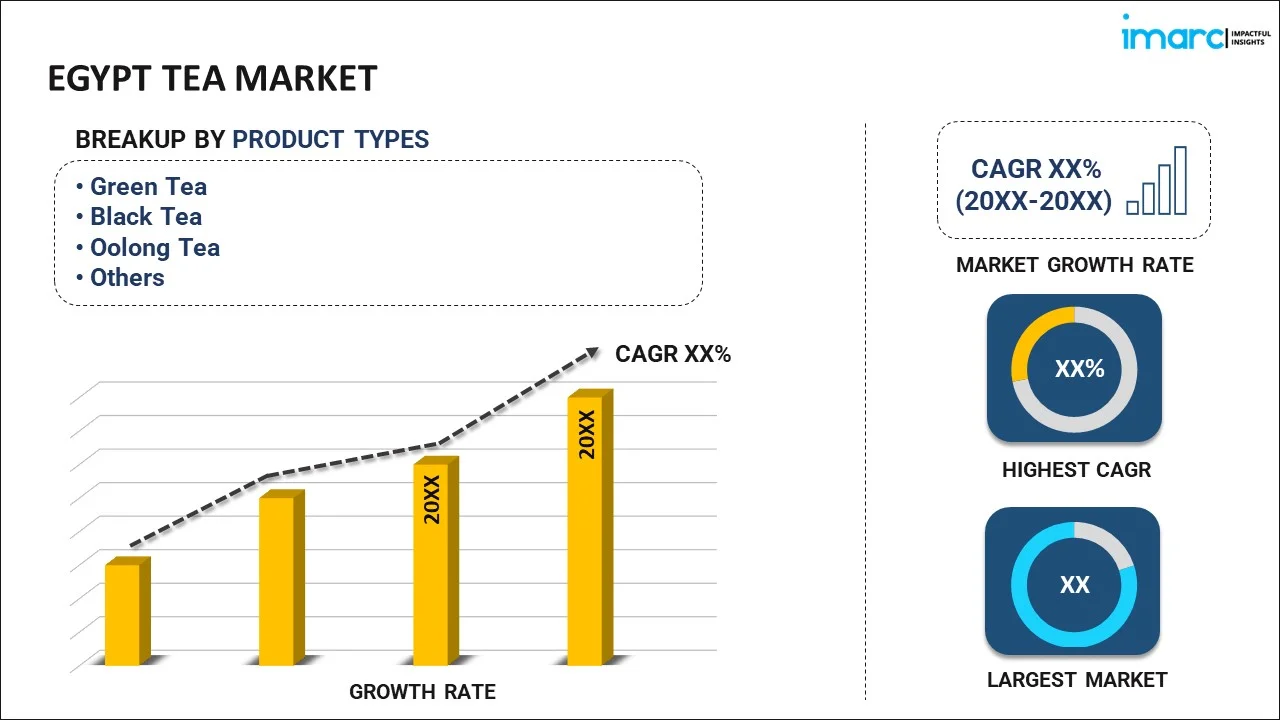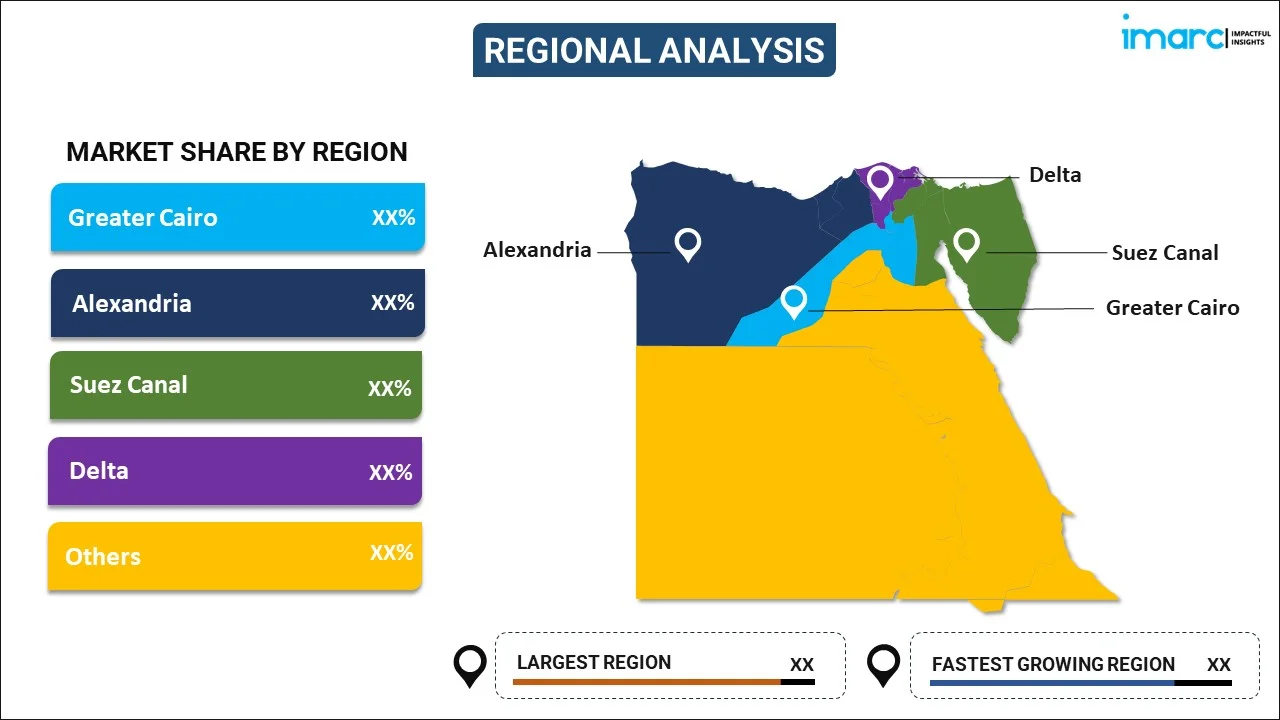
Egypt Tea Market Report by Product Type (Green Tea, Black Tea, Oolong Tea, and Others), Packaging (Plastic Containers, Loose Tea, Paper Boards, Aluminium Tin, Tea Bags, and Others), Distribution Channel (Supermarkets/Hypermarkets, Specialty Stores, Convenience Stores, Online, and Others), Application (Residential, Commercial), and Region 2025-2033
Egypt Tea Market Overview:
The Egypt tea market size is projected to exhibit a growth rate (CAGR) of 5.89% during 2025-2033. The increasing health awareness, the rising preference for herbal teas, expanding export opportunities, government initiatives, and development of favorable health environment represents some of the key factors driving the growth of the market.
|
Report Attribute
|
Key Statistics
|
|---|---|
|
Base Year
|
2024 |
|
Forecast Years
|
2025-2033 |
|
Historical Years
|
2019-2024
|
| Market Growth Rate (2025-2033) | 5.89% |
Egypt Tea Market Trends:
Increasing Health Awareness and Preference for Herbal Teas
One of the fundamental factors that has greatly influenced the positive growth of tea in the Egyptian market is the growing health and wellness concerns. Consumers are increasingly favoring natural products, which has led to a surge in interest and consumption of herbal teas. In Egypt, popular varieties, such as chamomile, hibiscus, and mint teas, are not only enjoyed for their flavors, but also for their health benefits. These include stress relief, aiding digestion, and providing antioxidants, among other advantages. Egypt Ranks Fourth Globally in Herbal Medicine Exports for 2022. All these factors have enhances the consumption of healthy teas, thereby boosting their domestic as well as export demand.
Expanding Export Opportunities and Government Initiatives
The demand for tea in Egypt is on the rise because of the increase in export opportunities such as export licenses and support from the government. Egypt's exports to African countries surged by 13 percent between January and October 2023, reaching a total of $6 billion. Egypt holds the largest share of intra-trade within the Common Market for Eastern and Southern Africa (COMESA). In 2022, the trade volume between Egypt and COMESA countries reached its highest level, totaling $4.3 billion. In November, the Central Agency for Public Mobilization and Statistics (CAPMAS) reported a 15.6 percent increase in Egypt's exports to COMESA countries in 2022, reaching $3,544 million compared to $3,066 million in 2021. The country remains favorably located and has a good and conducive climatic condition, which makes it possible to produce teas that meet international standards. The Egyptian government is actively promoting the export of agricultural products such as tea by providing incentives, developing favorable physical infrastructure, and facilitating access to global markets. These initiatives are intended to elevate the presence of Egyptian tea worldwide. Additionally, Egypt's participation in international trade fairs and exhibitions highlights local tea brands, further boosting exports. Therefore, it is evident that the government's strategic efforts to develop the tea industry, coupled with increasing global interest in luxury, high-quality tea products, are key factors positively impacting the tea market in Egypt.
Egypt Tea Market News:
-
In June 2024, i'SUPPLY, a healthtech company based in Egypt, has secured a pre-Series A funding round led by Disruptech Ventures, with contributions from OneStop Capital, Axian Investment CVC, Egypt Ventures, and other investors. This funding aims to support the company's expansion, enhance its financial services for small and medium-sized pharmacies, and improve its fintech and technology solutions. This follows a $1.5 million pre-seed round that the company raised nearly two years ago, also led by Disruptech Ventures.
Egypt Tea Market Segmentation:
IMARC Group provides an analysis of the key trends in each segment of the market, along with forecasts at the country level for 2025-2033. Our report has categorized the market based on product type, packaging, distribution channel, and application.
Product Type Insights:

- Green Tea
- Black Tea
- Oolong Tea
- Others
The report has provided a detailed breakup and analysis of the market based on the product type. This includes black tea, green tea, oolong tea, and others.
Packaging Insights:
- Plastic Containers
- Loose Tea
- Paper Boards
- Aluminium Tin
- Tea Bags
- Others
A detailed breakup and analysis of the market based on the packaging have also been provided in the report. This includes plastic containers, loose tea, paper boards, aluminium tin, tea bags and others.
Distribution Channel Insights:
- Supermarkets/Hypermarkets
- Specialty Stores
- Convenience Stores
- Online
- Others
The report has provided a detailed breakup and analysis of the market based on the distribution channel. This includes supermarkets/hypermarkets, specialty stores, convenience stores, online, and others.
Application Insights:
- Residential
- Commercial
The report has provided a detailed breakup and analysis of the market based on the application. This includes residential and commercial.
Regional Insights:

- Greater Cairo
- Alexandria
- Suez Canal
- Delta
- Others
The report has also provided a comprehensive analysis of all the major regional markets, which include Greater Cairo, Alexandria, Suez Canal, Delta, and Others.
Competitive Landscape:
The market research report has also provided a comprehensive analysis of the competitive landscape. Competitive analysis such as market structure, key player positioning, top winning strategies, competitive dashboard, and company evaluation quadrant has been covered in the report. Also, detailed profiles of all major companies have been provided.
Egypt Tea Market Report Coverage:
| Report Features | Details |
|---|---|
| Base Year of the Analysis | 2024 |
| Historical Period | 2019-2024 |
| Forecast Period | 2025-2033 |
| Units | Million USD |
| Scope of the Report | Exploration of Historical Trends and Market Outlook, Industry Catalysts and Challenges, Segment-Wise Historical and Future Market Assessment:
|
| Product Types Covered | Green Tea, Black Tea, Oolong Tea, Others |
| Packagings Covered | Plastic Containers, Loose Tea, Paper Boards, Aluminium Tin, Tea Bags, Others |
| Distribution Channels Covered | Supermarkets/Hypermarkets, Specialty Stores, Convenience Stores, Online, Others |
| Applications Covered | Residential, Commercial |
| Regions Covered | Greater Cairo, Alexandria, Suez Canal, Delta, Others |
| Customization Scope | 10% Free Customization |
| Post-Sale Analyst Support | 10-12 Weeks |
| Delivery Format | PDF and Excel through Email (We can also provide the editable version of the report in PPT/Word format on special request) |
Key Questions Answered in This Report:
- How has the Egypt tea market performed so far and how will it perform in the coming years?
- What has been the impact of COVID-19 on the Egypt tea market?
- What is the breakup of the Egypt tea market on the basis of product type?
- What is the breakup of the Egypt tea market on the basis of packaging?
- What is the breakup of the Egypt tea market on the basis of distribution channel?
- What is the breakup of the Egypt tea market on the basis of application?
- What are the various stages in the value chain of the Egypt tea market?
- What are the key driving factors and challenges in the Egypt tea?
- What is the structure of the Egypt tea market and who are the key players?
- What is the degree of competition in the Egypt tea market?
Key Benefits for Stakeholders:
- IMARC’s industry report offers a comprehensive quantitative analysis of various market segments, historical and current market trends, market forecasts, and dynamics of the Egypt tea market from 2019-2033.
- The research report provides the latest information on the market drivers, challenges, and opportunities in the Egypt tea market.
- Porter's five forces analysis assist stakeholders in assessing the impact of new entrants, competitive rivalry, supplier power, buyer power, and the threat of substitution. It helps stakeholders to analyze the level of competition within the Egypt tea industry and its attractiveness.
- Competitive landscape allows stakeholders to understand their competitive environment and provides an insight into the current positions of key players in the market.
Need more help?
- Speak to our experienced analysts for insights on the current market scenarios.
- Include additional segments and countries to customize the report as per your requirement.
- Gain an unparalleled competitive advantage in your domain by understanding how to utilize the report and positively impacting your operations and revenue.
- For further assistance, please connect with our analysts.
 Inquire Before Buying
Inquire Before Buying
 Speak to an Analyst
Speak to an Analyst
 Request Brochure
Request Brochure
 Request Customization
Request Customization




.webp)




.webp)












